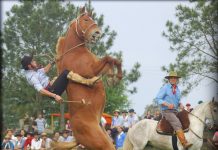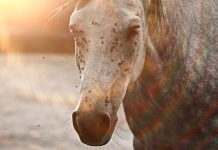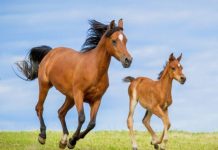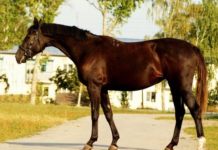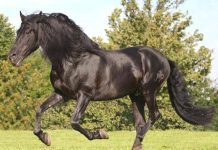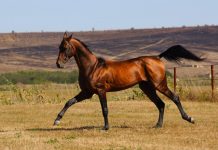Colorful variety for leisure and tournaments. Do you want to buy a pinto horse? Understandable, because the pretty piebalds are enjoying growing popularity.
Everyone knows it from its striking drawing: the pinto horse. They quickly think of colorful western horses, ridden by cowboys and Indians.
But: A pinto horse is not a breed in itself. Therefore, there are a few things to consider when choosing.
In this article, you will find out everything you need to know about these versatile four-legged friends.
Breed description

The word “pinto” is derived from the Spanish word “pinta”, which means something like “stain”. This designation covers all horses whose fur shows the typical, plate-shaped spotting.
It does not matter whether it is a brown and white or a black and white pinto. The pinto horse is therefore a color name and not a horse breed of its own.
As long as the color is present from birth, the animal is called a pinto horse.
Basically, a single colored spot is sufficient for this. This must be at least 500 cm³ and must be above the hocks, but outside of the head mark.
In addition, a viewer must be able to recognize it from the stand.
Size: 115 – 170 cm
Weight: 300 – 400 kg
Origin: Spain
Lifespan: 20-30 years
Color: Basic color with the typical white spotting in plate form
Suitable as: leisure
Origin and breed history
Even if the pinto horse is seen as the classic Indian horse: It originally comes from Spain. It only came to America in the 16th century when it was settled by Spanish immigrants.
In Germany, the pinto horse is now bred according to established standards. The method of the open studbook is used for this purpose.
This means that horses and ponies of other breeds are crossed in order to obtain the special color pattern:
- German riding horse and riding pony
- Anglo-Arabs, Arabs, Shagya Arabs, and Thoroughbred Arabs
- Lippizaner
- Palominos
- Western horses: Appaloosa, Paint Horse or the Quarter Horse
- Ponies: Connemara, Shetland, Dartmoor, Falabella
- Palatinate-Ardennes, Rhenish-German and Schleswig-Holstein draft horses
- Tinker and Irish Tinker
- A pinto horse can be anything from Arabs to heavy cold-blooded horses.
The height of the stick and the build vary accordingly. The performance of the Pinto horse is also defined by the breed it comes from.
For a long time, it was rumored that piebald horses were less productive than their monochrome representatives.
In the meantime, however, this has been refuted. It is important to recognize and promote the individual talents of the Pinto horse at an early stage.
The appearance of the pinto horse
Because many different breeds can develop the color Pinto, their appearance is very diverse.
The size also varies: from the small Falabella pony to the heavy Schleswig draft horse, every height is represented.
However, there are different versions of the piebald pattern. Then the pintos are classified.
The coloring of the pinto horse
There are four different color types for the pinto horse. They are not always clearly distinguishable from one another, as the transitions are often fluid.
Tobiano
- Denotes the dominant plate check.
- Smooth, harmonious contours.
- The white crosses the backline in at least one place.
- The tail is two-colored.
- The legs are white.
Overo
- Describes the recessive plate check.
- Torn, restless contours.
- No white on the back line.
- Monochromatic tail.
- Legs and head in the basic color.
Tovero
Denotes a hybrid of Tobiano and Overo
Sabino
It is very difficult to determine due to the wide variety of characteristics.
Possible signs of a Sabino piebald are:
- White spots on the head can also merge into a lantern.
- White spots on the stomach can flow together into larger ones.
- White burin hair that can stretch over the entire body.
What is a baroque pinto?
This describes a special form of the pinto horse. Baroque pintos are characterized by the fact that they contain at least 25% Frisian blood. Therefore, the royal drawing in black and white is typical.
Your physique appears rectangular and harmonious. Baroque pintos reach a height of up to 165 cm.
A noble head with a slightly concave nasal bone and conspicuous hangings are also standards of this breed.
Temperament and essence
Depending on which breed the Pinto horse is based on, nature also varies. Therefore, no general statements can be made about how your Pinto horse will behave.
In breeding, however, emphasis is placed on producing animals that are easy to get along with and have strong nerves. In addition, your pinto horse generally brings robust health and psychological stability to the table.
Due to its balanced temperament, the pinto horse is suitable for all riding and driving styles. Due to their unusual drawing, they are also very popular as show horses.
Husbandry and nutrition

Attitude
A pinto horse feels most comfortable in the pasture and in contact with its fellow horses. His senses need to be occupied. That is why absolute solitude damages his psyche.
It tends to behave abnormally and gets sick more quickly. Even if the pinto horse does not have any higher demands on its posture than other horse breeds: think about its nutrition and accommodation in advance.
There are different ways of keeping pinto horses. Stable housing or open stable. Inner box or outer box. All of them have advantages and disadvantages. In addition to your own needs, it is essential to put those of your horse in the foreground.
The most important thing is probably the need for exercise. As escape animals, horses are made to run for many hours. Not to stand tied up in the stable.
In addition to riding, you can take your horse to the paddock, take him for a walk or do the groundwork. When kept in groups, your Pinto horse can interact to its heart’s content with its fellow horses. If there is enough space, you also cover part of his exercise needs at the same time.
It is important to make sure that your pinto horse fits into the herd and integrates well. Horses are permanent eaters. This means that they have a very short digestive system. This can only function properly if they eat frequently.
Nutrition
Wild horses, therefore, spend up to 12 hours a day eating. Even if your pinto horse does not live in the wild – it also always needs access to fresh, species-appropriate feed.
This will prevent indigestion. Because eating breaks that are too long stress the pinto horse. The intestinal bacteria die. The consequences are colic and unwanted behavior problems such as clipping or weaving.
The chewing process itself ensures that the teeth wear out appropriately. In addition, the horse remains busy and feels good. Make sure that your horse always has enough hay or grass so that it can eat for several hours.
Concentrated feed, such as oats, may only be given in appropriate quantities. This depends on what you want to use your Pinto horse for primarily.
You should also only feed fruit, vegetables, and treats in moderation.
Education and care
Upbringing
Basically, as with any horse training: You should try to train your horse with the necessary rigor right from the start.
However, you shouldn’t get loud or aggressive.
Maintenance
Regularly grooming your pinto horse is one of your duties as a horse owner. The best thing to do is to get a cleaning case with the following basic equipment:
- A rubber curl to remove coarse dirt.
- A grooming brush to brush the dust from fur, mane, and tail.
- A hoof picks to remove stones and lumps.
- A mane comb to detangle the thick hair.
Cleaning your pinto horse regularly will help keep it healthy. The skin is better supplied with blood. The fur remains shiny and soft. But don’t overdo it.
A little dirt won’t harm your pinto horse. On the contrary. It is important that you clean the fur under the saddle well before riding. Otherwise, painful pressure points will form.
You also need to check your hooves regularly. A trapped stone is painful. The consequences are lameness and misalignment of the legs.
Health and Typical Diseases
With the pinto horse, care is taken to breed particularly healthy and robust horses. Therefore it is no more or less prone to disease than other horses.
So that your Pinto horse stays healthy in the long term, you should attach importance to a healthy diet, the right training, and the optimal posture.
Life expectancy
The life expectancy of your Pinto horse also depends on the breed. Ponies can live up to thirty years old, while cold-blooded animals only live around twenty.
Genetic factors, housing conditions, and the individual constitution can also influence life expectancy. Even with a pinto horse, you should definitely be aware that you will take responsibility for a living being for many years.
Under certain circumstances, this can be associated with high costs. Accommodation, food, vet, farrier, equipment – all of this regularly costs money.
Buy Pinto horse breed
If you are looking to buy a pinto horse, take your time making a decision. Contact the breeders’ association or scour the classifieds.
Make sure not only to fall in love with the look but also see if the chemistry between you is right.
In terms of price, you have to calculate between $2200 and $5500 for a Pinto horse, depending on the pedigree and training.
Decision support
To make your decision easier, you will find three Pinto horses of different breeds here. With its height of 1.55 meters, the Paint Horse is well suited for heavy adults.
Her strong muscles make her an ideal western and leisure horse. The German riding pony with pinto drawing is ideal for children and teenagers.
It convinces with lively corridors and its elegant charisma. If you want to use your Pinto horse for driving, the Pinto Lewitzer is recommended.
The cross between Arabian, riding pony, and thoroughbred has produced a willing and persistent pinto horse.
So you see: Finding the right pinto horse for you can be a challenge. For this, you will be rewarded with a companion who will go through thick and thin with you.
FAQ: Frequently asked questions

What is a pinto?
The pinto is a warmblood horse originating in America. The word “pinto” comes from the Spanish word “pinta” and means “stain”. Pinto is actually not a breed but describes the horses that can have a piebald in addition to their basic color from birth.








